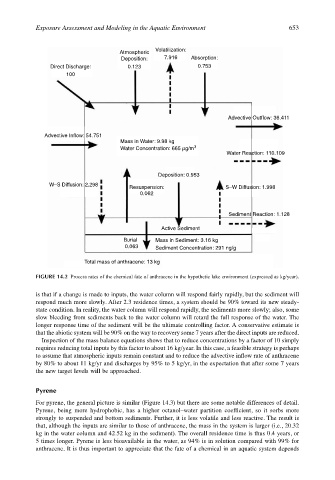Page 673 - The Toxicology of Fishes
P. 673
Exposure Assessment and Modeling in the Aquatic Environment 653
Volatilization:
Atmospheric
Deposition: 7.916 Absorption:
Direct Discharge: 0.123 0.753
100
Advective Outflow: 36.411
Advective Inflow: 54.751
Mass in Water: 9.98 kg
Water Concentration: 665 µg/m 3
Water Reaction: 110.109
Deposition: 0.953
W–S Diffusion: 2.298
Resuspension: S–W Diffusion: 1.998
0.062
Sediment Reaction: 1.128
Active Sediment
Burial Mass in Sediment: 3.16 kg
0.063 Sediment Concentration: 291 ng/g
Total mass of anthracene: 13 kg
FIGURE 14.2 Process rates of the chemical fate of anthracene in the hypothetic lake environment (expressed as kg/year).
is that if a change is made to inputs, the water column will respond fairly rapidly, but the sediment will
respond much more slowly. After 2.3 residence times, a system should be 90% toward its new steady-
state condition. In reality, the water column will respond rapidly, the sediments more slowly; also, some
slow bleeding from sediments back to the water column will retard the full response of the water. The
longer response time of the sediment will be the ultimate controlling factor. A conservative estimate is
that the abiotic system will be 90% on the way to recovery some 7 years after the direct inputs are reduced.
Inspection of the mass balance equations shows that to reduce concentrations by a factor of 10 simply
requires reducing total inputs by this factor to about 16 kg/year. In this case, a feasible strategy is perhaps
to assume that atmospheric inputs remain constant and to reduce the advective inflow rate of anthracene
by 80% to about 11 kg/yr and discharges by 95% to 5 kg/yr, in the expectation that after some 7 years
the new target levels will be approached.
Pyrene
For pyrene, the general picture is similar (Figure 14.3) but there are some notable differences of detail.
Pyrene, being more hydrophobic, has a higher octanol–water partition coefficient, so it sorbs more
strongly to suspended and bottom sediments. Further, it is less volatile and less reactive. The result is
that, although the inputs are similar to those of anthracene, the mass in the system is larger (i.e., 20.32
kg in the water column and 42.52 kg in the sediment). The overall residence time is thus 0.4 years, or
5 times longer. Pyrene is less bioavailable in the water, as 94% is in solution compared with 99% for
anthracene. It is thus important to appreciate that the fate of a chemical in an aquatic system depends

